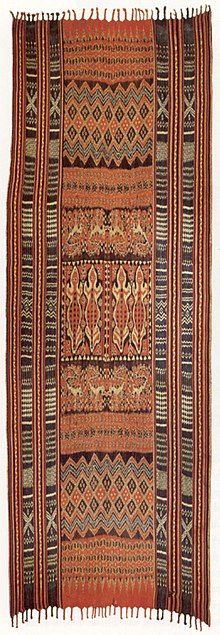
Back Ікат Byelorussian ইকাত Bengali/Bangla Ikat Catalan Ikat Czech Ikat German Ikat Spanish داراییبافی Persian Ikat Finnish Ikat French Tenun ikat ID
 | |
| Material | cotton, silk, silk cotton |
|---|---|
| Place of origin | Southeast Asia (Austronesian and Daic-speaking peoples) |
Ikat (literally "to bind" in Malayo-Polynesian languages) is a dyeing technique from Southeast Asia used to pattern textiles that employs resist dyeing on the yarns prior to dyeing and weaving the fabric. In Southeast Asia, where it is the most widespread, ikat weaving traditions can be divided into two general groups of related traditions. The first is found among Daic-speaking peoples (Laos, northern Vietnam, and Hainan). The second, larger group is found among the Austronesian peoples (Indonesia, Philippines, Malaysia, Brunei, and Timor-Leste) and spread via the Austronesian expansion to as far as Madagascar. It is most prominently associated with the textile traditions of Indonesia in modern times, from where the term ikat originates.[1] Similar unrelated dyeing and weaving techniques that developed independently are also present in other regions of the world, including India, Central Asia, Japan (where it is called kasuri), Africa, and the Americas.
In ikat, the resist is formed by binding individual yarns or bundles of yarns with a tight wrapping applied in the desired pattern. The yarns are then dyed. The bindings may then be altered to create a new pattern and the yarns dyed again with another colour. This process may be repeated multiple times to produce elaborate, multicolored patterns. When the dyeing is finished all the bindings are removed and the yarns are woven into cloth. In other resist-dyeing techniques such as tie-dye and batik the resist is applied to the woven cloth, whereas in ikat the resist is applied to the yarns before they are woven into cloth. Because the surface design is created in the yarns rather than on the finished cloth, in ikat both fabric faces are patterned. Ikat can be classified into three general types: warp ikat and weft ikat, in which the warp and weft yarns are dyed, respectively; and double ikat, where both the warp and weft yarns are dyed.
A characteristic of ikat textiles is an apparent "blurriness" to the design. The blurriness is a result of the extreme difficulty the weaver has lining up the dyed yarns so that the pattern comes out perfectly in the finished cloth. The blurriness can be reduced by using finer yarns or by the skill of the craftsperson. Ikat with little blurriness, multiple colours and complicated patterns are more difficult to create and therefore often more expensive. However, the blurriness that is so characteristic of ikat is often prized by textile collectors.